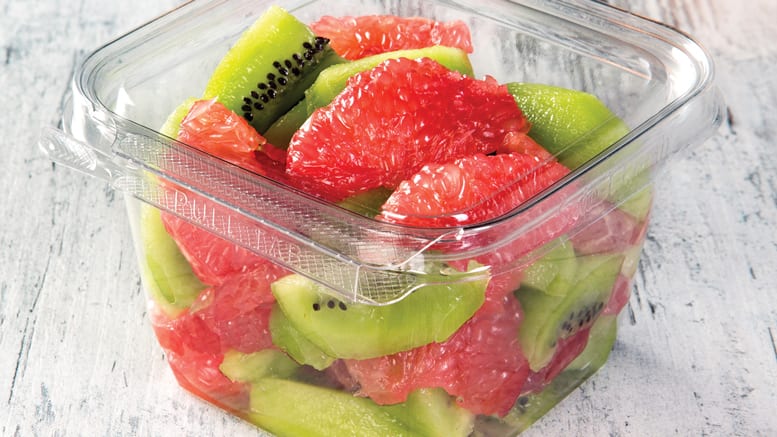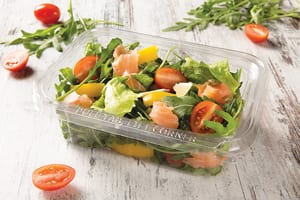RISE OF THE CLAMSHELLS
January 2, 2019 | 6 min to read
Clamshell packaging has become popular for produce as it offers sightlines, protection, and food safety. Consumers prefer clamshells for their visibility, convenience, and added tamper-resistance, ensuring fruits and vegetables remain fresh and appealing. They also provide an opportunity for retailers to showcase products while emphasizing their environmentally-friendly and recyclable aspects. Enhanced designs and technology improvements have led to lighter, more efficient packaging, addressing both sustainability concerns and consumer preferences for quality produce.

Originally printed in the January 2019 issue of Produce Business.
Containers provide the ultimate in sightlines, protection and food safety for produce.
 Think about what shoppers in the produce section want. Of course, they’re looking for delicious and healthy fruits and vegetables, goods that look perfect and that they are confident are safe to eat.
Think about what shoppers in the produce section want. Of course, they’re looking for delicious and healthy fruits and vegetables, goods that look perfect and that they are confident are safe to eat.
That’s what makes clamshell packaging so popular.
Clamshell packages make fruits and vegetables, especially smaller varieties, easy to display, which in turn makes it easy for consumers to inspect those foods. If you’re buying, for example, grape tomatoes, a bag makes it difficult to inspect everything in the package. And selling smaller foods individually makes little sense, as it’s not convenient and is sure to result in lots of spillage and waste.
“Consumers will pay a premium for safety and convenience, both of which a clamshell container offers,” says Sarah Korwek, product manager for Inline Plastics, headquartered in Shelton, CT. “Enhanced leak-resistance, the ability to re-seal the contents, tamper-resistance and environmentally responsible packaging that can be easily recycled are all components of Inline’s clamshells that have been shown to attract consumers and increase sales.”
It’s easy to see why clamshells have so much appeal. First, they allow shoppers to clearly see the fruits and vegetables inside the packaging — consumers can see exactly how much produce they’re buying, and the quality of the food itself. For example, if you’re buying strawberries or blueberries, you can hold up the package and inspect the fruit inside, even the berries on the bottom.
And because they’re durable, clamshells send a signal that the fruit inside has been well-protected through the shipping and delivery processes.
WHAT MAKES A CLAMSHELL A CLAMSHELL?
Roman Forowycz, vice president of business development for Sonoco Global Flexibles, based in Hartsville, SC, says industry standards usually refer to rigid plastic packaging as “clams” or “clamshells.”
“This includes hinged containers, two-piece plastic trays with a rigid top and bottom, as well as a tray with film,” he says. “There are some standardized sizes for various types of vegetables and fruits. Within those standard footprints, there is customization of appearance and performance. For example, tomatoes and berries have standard sizes to fit shipping containers. Lettuce is similar with 5-ounce, 10-ounce and 1-pound sizes.”
Sam Monte of Monte Package Company, based in Riverside, MI, notes that clamshells are usually represented by a RPET/PET, one-piece containers with a hinged lid that closes either via friction or button locks.
“It opens and closes like a seafood clam, hence the name,” he says, adding that the standard sizes include 1-pint, 1-pound and 18-ounce packages, but that technology and availability are advancing, which is leading to more options and custom-shaped clamshells.
GETTING IN SHAPE
When it comes to shapes of clamshell packages, Forowycz says rectangles and squares are the most popular options because they provide efficiency in terms of shipping and merchandising.
Aside from shape, he says key attributes that affect the quality of clamshells are transparency, protection from distribution abuse, shelf-life extension, re-sealability, and sustainability.
“Buyers should specify size, level of protection required — will there be automation required? — rigidity, transparency, ease of opening and number of recloses expected, recyclability needs and target cost,” says Forowycz.
Monte notes other factors buyers should look for in clamshell packaging.
“Packers putting commodities in a clam should have an understanding of air-flow requirements, moisture levels and marketing requirements,” he says.
According to Inline’s Korwek, there are five key components that determine the appropriate clamshell packaging. The first is the product itself, meaning which produce is going into the package.
Second is volume — how much of that produce will be fit into the container.
Other factors are dimensions, the produce weight, and clamshells that are tamper-evident, tamper-resistant and leak-resistant.
“These, along with many other inputs, are important specifications buyers need to provide to determine the correct clamshell packaging for their needs,” says Korwek.
CLAMSHELL APPEAL
Korwek says consumers are drawn to clamshells because of the protection they offer, their 100-percent recyclability, and because they’re virtually crystal-clear.
“You have multiple features that will drive consumers to make that choice,” she says. “With these features, you provide confidence your food is safe from tampering and won’t leak on the ride home from the grocery store.”
Also, she says clamshell packaging offers value-adds to produce.
“It offers both greater protection of the contents, leak-resistant properties — imperative when shipping produce — as well as increases the merchandising opportunities for retailers,” says Korwek. “Our customers have found that impulse sales increase with the attractive and convenient packaging a clamshell offers.”
Furthermore, she notes, clamshells offer an added layer of protection for fruits and vegetables that are prone to bruising, so they keep fresher for a longer period of time than other forms of packaging while adding visual appeal.
“They allow retailers to highlight new varieties or premium versions by showcasing the cut produce inside the clamshell; as well as provide an option to mix-and-match produce for alternative buying options,” says Korwek. “Lastly, the clamshell itself provides space to educate and share messaging on organic and specialty items.”
KEEPING FOOD SAFE
One key concern that clamshell packages address is food safety.
“Tamper-evident, tamper-resistant packaging is extremely important,” says Korwek. “It provides an added level of assurance for retailers and consumers when making a purchasing decision. It ensures that contents have not been removed — resulting in a lower-quantity over the stated label — or contaminated — causing a potential health risk. In fact, Inline was the first container manufacturer to introduce tamper-resistant and tamper-evident clamshells with our Safe-T-Fresh line.”
Monte also notes the importance of tamper-proof clamshell packages.
“When it comes to an individual or family-size, fresh-cut or ‘ready-to-eat’ product, the package must be tamper proof,” he says. “We are seeing a trend across all categories for more tamper-proof requests in packaging, regardless of whether they are fresh cut or not.”
NEW AND IMPROVED DESIGNS
One reason clamshell packages are making more of an impact these days is because technology has led to more variety in shapes and sizes, and improved quality.
“The growth of uniquely shaped clamshells in an assortment of sizes has resulted in an increase as well in the customization of boxes and pallets,” says Korwek.
“However, some standard berry containers do still conform to the common footprint.”
Inline’s designs utilize tamper-resistant and improved perimeter-sealing technology, along with offering new shapes and sizes.
“We pride ourselves on leading the industry in packaging innovations,” she says. “When it comes to the weight of the clamshells specifically, Inline, like many manufactures, strives to find the optimal use of material for their packages. This entails how to balance keeping the containers lightweight and easily recyclable, but also sturdy enough to protect the contents and support shelf stacking.”
THE BEST FRUITS FOR CLAMSHELLS
Shoppers have no doubt noticed that certain specific fruits and vegetables are found in clamshell packaging. These include berries, grape tomatoes, and grapes.
“Typically more delicate products are displayed in rigid clamshells,” says Forowycz. “The packaging protects from bruising. However, rigid clamshells also provide consistent head space for air or other gases as compared to bags, generally resulting in longer shelf life.”
Korwek notes that the benefits of clamshells include an added layer of protection for those fruits and veggies that are susceptible to bruising, which means fresher, longer-lasting, and more visually appealing produce.
“They allow retailers to highlight new varieties or premium versions by showcasing the cut produce inside the clamshell, as well as provide an option to mix-and-match produce for alternative buying options,” she says. “Lastly, the clamshell itself provides space to educate and share messaging on organic and specialty items.”
It all adds up to packaging that many customers find appealin. Supermarket produce managers can do themselves a favor by putting a spotlight on foods in clamshell packages.
ENVIRONMENTAL CONCERNS
 Roman Forowycz, vice president of business development for Sonoco Global Flexibles, Hartsville, SC, notes that not all clamshells confirm to standard footprint boxes and pallets, but that the majority of them do. And advances continue to be made in the design of packaging, including weight. This makes them popular for various reasons, including lessening their impact on the environment.
Roman Forowycz, vice president of business development for Sonoco Global Flexibles, Hartsville, SC, notes that not all clamshells confirm to standard footprint boxes and pallets, but that the majority of them do. And advances continue to be made in the design of packaging, including weight. This makes them popular for various reasons, including lessening their impact on the environment.
“Definitely, most clamshells are lighter than they were 10 years ago,” he says. “This is being driven by sustainability concerns, as well as cost pressures. For example, water and soda bottles were made much lighter over the past decade, and this change resulted in billions of pounds of plastic being saved and reduced impact on the environment.”
Monte also says clamshells are changing to fit modern trends.
“Technology and recycling advances have made the standard sizes more efficient and economical to produce and sell to growers and packers — small and large — without deteriorating the quality,” he says.
And these advances have benefited produce sections.
“Technology and recycling advances have made the standard sizes more efficient and economical to produce and sell to growers and packers, small and large, without deteriorating the quality,” says Sarah Korwek, product manager for Inline Plastics, Shelton, CT.
The next step in environmentally friendly clamshell-like packaging could be on its way.
“Over the past 10 years, using recycled content in Thermoformed plastic and/or reducing material weight have become standard practices,” says Sara Lozano, marketing manager for Sambrailo Packaging, based in Watsonville, CA.
Lozano says the pros of clamshells include their availability, the low cost, and their stature as the industry standard. But they also have their downside, including, she says, their impact on the environment. “Plastic is single-use, and recycling is no longer effective,” she says, adding that other cons include their lack of “marketing real estate,” which is limited to the top label.
Sambrailo has an alternative to plastic clamshells with its ReadyCycle packaging, which Lozano says reduces plastic waste. These non-waxed paperboard boxes are 100-percent recyclable and offer design flexibility. Sizes include a 16-ounce option for strawberries, as well as 6-ounce, 12-ounce, and 32-ounce packages.
5 of 20 article in Produce Business January 2019

